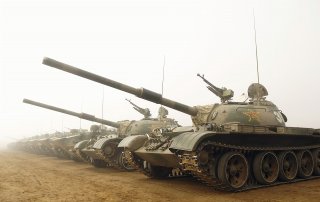China Is Turning Pakistan into a Regional Military Power—Here's Why
China has no scruples about supplying Pakistan with state-of-the art weapons systems.
Here's What You Need To Remember: The Pakistan-China relationship makes sense: China would like an ally in the region to help balance against India while Pakistan needs a foreign supplier of weapons and weapons technology.
The Pakistan-China defense relationship has progressively deepened since Pakistan’s relationship with the United States began fraying in recent years. These two Chinese-derived tanks illustrate the Chinese-Pakistan arms relationship.
Al-Zarrar
The Al-Zarrar tank is a Pakistani-operated variant of China’s Type 59 main battle tank, which is itself a copy of the Soviet Union’s T-54 tank.
Back in 2003, China partnered with Pakistan in upgrading Pakistan’s Chinese-bought Type 59 tanks to the Al-Zarrar standard, enhancing the tank’s mobility, firepower, and armor protection.
The original 100-millimeter main gun was replaced by a 125-millimeter smoothbore gun, increasing firepower. A modern computerized fire control system was also introduced for improved target acquisition and accuracy. A thermal imaging system was also installed, giving the Al-Zarrar night-time target acquisition capabilities.
Armor was also upgraded. Large explosive-reactive armor paneling was installed on the turret and the hull, improving survivability against some kinds of projectiles.
It is a fairly small tank at just 44 tons, but despite this it is not the most mobile of platforms due to the Al-Zarrar’s modest 730 horsepower diesel engine. Though it is small, the Al-Zarrar has a crew of four: a gunner, driver, loader, and commander.
In 2019, the Al-Zarrar claimed a bit of fame. The Pakistani Army reported that the tank was operating at 12,000 feet above sea level, which Pakistan claimed was a world-record. While indeed impressive, Indian media has pushed back, saying it may not actually be a world record after all.
Al-Khalid I & II
In addition to a number of airframes, drones, and missiles that China has supplied to Pakistan, the Al-Khalid is one of the more complex pieces of military equipment.
The Al-Khalid tank is substantially more capable than the Al-Zarrar. It was developed in tandem with China in the 1990s and is based on a Chinese prototype that eventually would become China’s impressive Type 99 main battle tank.
One of the design challenges that had to be overcome was Pakistan’s terrain. An adequate cooling system, both for the engine and the crew had to be developed to deal with high ambient temperatures typical in Pakistan. An adequate air filtration system also had to be fitted to filter out the fine dust that is also endemic to Pakistan.
Like the Al-Zarra, the Al-Khalid has a 125-millimeter smoothbore gun that is compatible with Pakistani depleted uranium rounds, which gives the Al-Khalid good penetration capabilities.
The Al-Khalid does not suffer from the reduced mobility of the older Al-Zarrar, but rather is powered by a 1,200 horsepower diesel engine that was developed by Ukraine for the Al-Khalid project.
The upgraded Al-Khalid II featured a redesigned turret with better protection and explosive reactive paneling. It also has an upraised, 1,500 horsepower engine that further increases the Al-Khalid’s mobility. The internal air conditioning system was also upgraded for crew comfort.
Future Plans
The Pakistan-China relationship makes sense. China would like an ally in the region to help balance against its regional rival India, which is sandwiched between the two countries. Pakistan in turn needs a foreign supplier of weapons and weapons technology, especially as the Pakistan-United States relationship has unraveled.
What better defense partner than China, who does not have any scruples about supplying Pakistan with state-of-the art weapons systems.
Caleb Larson is a Defense Writer with The National Interest. He holds a Master of Public Policy and covers U.S. and Russian security, European defense issues, and German politics and culture.
This article first appeared earlier last year and is being reprinted due to reader interest.

